2010 NISSAN 370Z COUPE light
[x] Cancel search: lightPage 366 of 409
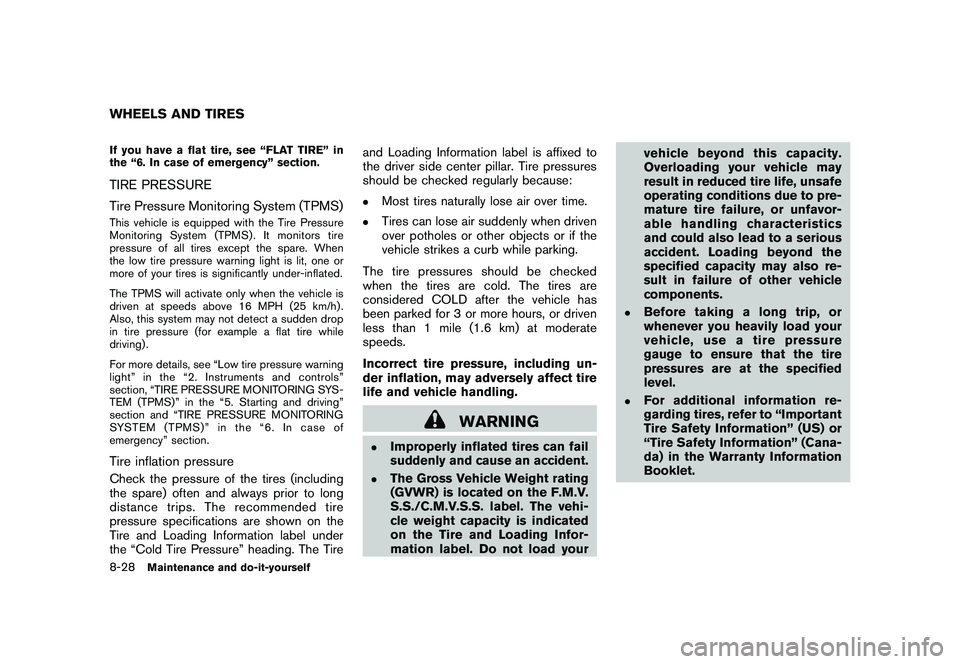
Black plate (368,1)
Model "Z34-D" EDITED: 2009/ 9/ 10
If you have a flat tire, see “FLAT TIRE” in
the “6. In case of emergency” section.TIRE PRESSURE
Tire Pressure Monitoring System (TPMS)This vehicle is equipped with the Tire Pressure
Monitoring System (TPMS) . It monitors tire
pressure of all tires except the spare. When
the low tire pressure warning light is lit, one or
more of your tires is significantly under-inflated.
The TPMS will activate only when the vehicle is
driven at speeds above 16 MPH (25 km/h) .
Also, this system may not detect a sudden drop
in tire pressure (for example a flat tire while
driving) .
For more details, see “Low tire pressure warning
light” in the “2. Instruments and controls”
section, “TIRE PRESSURE MONITORING SYS-
TEM (TPMS)” in the “5. Starting and driving”
section and “TIRE PRESSURE MONITORING
SYSTEM (TPMS)” in the “6. In case of
emergency” section.Tire inflation pressureCheck the pressure of the tires (including
the spare) often and always prior to long
distance trips. The recommended tire
pressure specifications are shown on the
Tire and Loading Information label under
the “Cold Tire Pressure” heading. The Tireand Loading Information label is affixed to
the driver side center pillar. Tire pressures
should be checked regularly because:
.
Most tires naturally lose air over time.
.
Tires can lose air suddenly when driven
over potholes or other objects or if the
vehicle strikes a curb while parking.
The tire pressures should be checked
when the tires are cold. The tires are
considered COLD after the vehicle has
been parked for 3 or more hours, or driven
less than 1 mile (1.6 km) at moderate
speeds.
Incorrect tire pressure, including un-
der inflation, may adversely affect tire
life and vehicle handling.
WARNING
.
Improperly inflated tires can fail
suddenly and cause an accident.
.
The Gross Vehicle Weight rating
(GVWR) is located on the F.M.V.
S.S./C.M.V.S.S. label. The vehi-
cle weight capacity is indicated
on the Tire and Loading Infor-
mation label. Do not load your vehicle beyond this capacity.
Overloading your vehicle may
result in reduced tire life, unsafe
operating conditions due to pre-
mature tire failure, or unfavor-
able handling characteristics
and could also lead to a serious
accident. Loading beyond the
specified capacity may also re-
sult in failure of other vehicle
components.
.
Before taking a long trip, or
whenever you heavily load your
vehicle, use a tire pressure
gauge to ensure that the tire
pressures are at the specified
level.
.
For additional information re-
garding tires, refer to “Important
Tire Safety Information” (US) or
“Tire Safety Information” (Cana-
da) in the Warranty Information
Booklet.
WHEELS AND TIRES8-28
Maintenance and do-it-yourself
Page 374 of 409
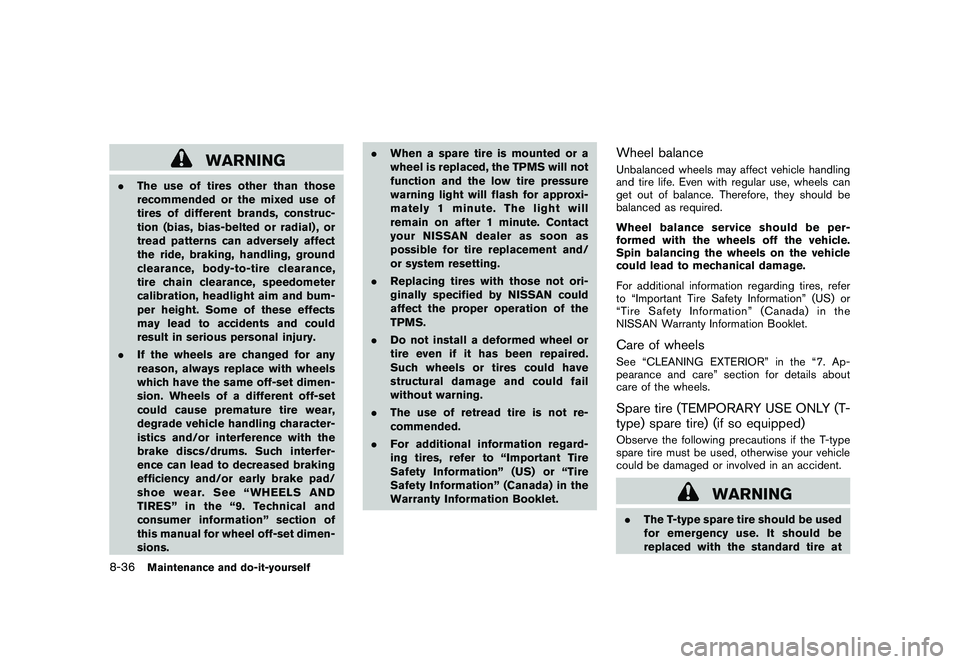
Black plate (376,1)
Model "Z34-D" EDITED: 2009/ 9/ 10
WARNING
.The use of tires other than those
recommended or the mixed use of
tires of different brands, construc-
tion (bias, bias-belted or radial) , or
tread patterns can adversely affect
the ride, braking, handling, ground
clearance, body-to-tire clearance,
tire chain clearance, speedometer
calibration, headlight aim and bum-
per height. Some of these effects
may lead to accidents and could
result in serious personal injury.
. If the wheels are changed for any
reason, always replace with wheels
which have the same off-set dimen-
sion. Wheels of a different off-set
could cause premature tire wear,
degrade vehicle handling character-
istics and/or interference with the
brake discs/drums. Such interfer-
ence can lead to decreased braking
efficiency and/or early brake pad/
shoe wear. See “WHEELS AND
TIRES” in the “9. Technical and
consumer information” section of
this manual for wheel off-set dimen-
sions. .
When a spare tire is mounted or a
wheel is replaced, the TPMS will not
function and the low tire pressure
warning light will flash for approxi-
mately 1 minute. The light will
remain on after 1 minute. Contact
your NISSAN dealer as soon as
possible for tire replacement and/
or system resetting.
. Replacing tires with those not ori-
ginally specified by NISSAN could
affect the proper operation of the
TPMS.
. Do not install a deformed wheel or
tire even if it has been repaired.
Such wheels or tires could have
structural damage and could fail
without warning.
. The use of retread tire is not re-
commended.
. For additional information regard-
ing tires, refer to “Important Tire
Safety Information” (US) or “Tire
Safety Information” (Canada) in the
Warranty Information Booklet.
Wheel balanceUnbalanced wheels may affect vehicle handling
and tire life. Even with regular use, wheels can
get out of balance. Therefore, they should be
balanced as required.
Wheel balance service should be per-
formed with the wheels off the vehicle.
Spin balancing the wheels on the vehicle
could lead to mechanical damage.
For additional information regarding tires, refer
to “Important Tire Safety Information” (US) or
“Tire Safety Information” (Canada) in the
NISSAN Warranty Information Booklet.Care of wheelsSee “CLEANING EXTERIOR” in the “7. Ap-
pearance and care” section for details about
care of the wheels.Spare tire (TEMPORARY USE ONLY (T-
type) spare tire) (if so equipped)Observe the following precautions if the T-type
spare tire must be used, otherwise your vehicle
could be damaged or involved in an accident.
WARNING
.The T-type spare tire should be used
for emergency use. It should be
replaced with the standard tire at
8-36
Maintenance and do-it-yourself
Page 375 of 409
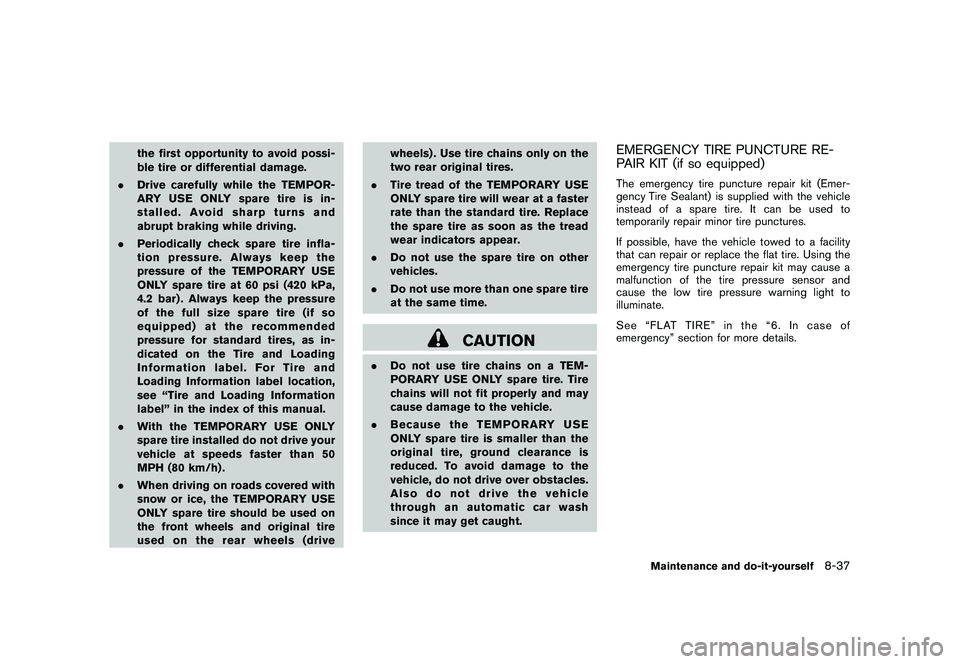
Black plate (377,1)
Model "Z34-D" EDITED: 2009/ 9/ 10
the first opportunity to avoid possi-
ble tire or differential damage.
. Drive carefully while the TEMPOR-
ARY USE ONLY spare tire is in-
stalled. Avoid sharp turns and
abrupt braking while driving.
. Periodically check spare tire infla-
tion pressure. Always keep the
pressure of the TEMPORARY USE
ONLY spare tire at 60 psi (420 kPa,
4.2 bar) . Always keep the pressure
of the full size spare tire (if so
equipped) at the recommended
pressure for standard tires, as in-
dicated on the Tire and Loading
Information label. For Tire and
Loading Information label location,
see “Tire and Loading Information
label” in the index of this manual.
. With the TEMPORARY USE ONLY
spare tire installed do not drive your
vehicle at speeds faster than 50
MPH (80 km/h) .
. When driving on roads covered with
snow or ice, the TEMPORARY USE
ONLY spare tire should be used on
the front wheels and original tire
used on the rear wheels (drive wheels) . Use tire chains only on the
two rear original tires.
. Tire tread of the TEMPORARY USE
ONLY spare tire will wear at a faster
rate than the standard tire. Replace
the spare tire as soon as the tread
wear indicators appear.
. Do not use the spare tire on other
vehicles.
. Do not use more than one spare tire
at the same time.
CAUTION
.Do not use tire chains on a TEM-
PORARY USE ONLY spare tire. Tire
chains will not fit properly and may
cause damage to the vehicle.
. Because the TEMPORARY USE
ONLY spare tire is smaller than the
original tire, ground clearance is
reduced. To avoid damage to the
vehicle, do not drive over obstacles.
Also do not drive the vehicle
through an automatic car wash
since it may get caught.
EMERGENCY TIRE PUNCTURE RE-
PAIR KIT (if so equipped)The emergency tire puncture repair kit (Emer-
gency Tire Sealant) is supplied with the vehicle
instead of a spare tire. It can be used to
temporarily repair minor tire punctures.
If possible, have the vehicle towed to a facility
that can repair or replace the flat tire. Using the
emergency tire puncture repair kit may cause a
malfunction of the tire pressure sensor and
cause the low tire pressure warning light to
illuminate.
See “FLAT TIRE” in the “6. In case of
emergency” section for more details.
Maintenance and do-it-yourself
8-37
Page 380 of 409

Black plate (382,1)
Model "Z34-D" EDITED: 2009/ 9/ 10
vehicles.
If any undesirable driveability problems such as
engine stalling or hard hot starting are experi-
enced after using oxygenate-blend fuels, im-
mediately change to a non-oxygenate fuel or a
fuel with a low blend of MTBE.
Take care not to spill gasoline during
refueling. Gasoline containing oxygenates
can cause paint damage.
E-85 fuelE-85 fuel is a mixture of approximately 85% fuel
ethanol and 15% unleaded gasoline. E-85 can
only be used in a Flexible Fuel Vehicle (FFV) . Do
not use E-85 fuel in your vehicle. U.S. govern-
ment regulations require fuel ethanol dispensing
pumps to be identified by a small, square,
orange and black label with the common
abbreviation or the appropriate percentage for
that region.Aftermarket fuel additivesNISSAN does not recommend the use of any
aftermarket fuel additives (Example: fuel injector
cleaner, octane booster, intake valve deposit
removers, etc.) which are sold commercially.
Many of these additives intended for gum,
varnish or deposit removal may contain active
solvent or similar ingredients that can be harmful
to the fuel system and engine.
Octane rating tipsUsing unleaded gasoline with an octane
rating lower than recommended above can
cause persistent, heavy spark knock.
(Spark knock is a metallic rapping noise.)
If severe, this can lead to engine damage.
If you detect a persistent heavy spark
knock even when using gasoline of the
stated octane rating, or if you hear steady
spark knock while holding a steady speed
on level roads, have a NISSAN dealer
correct the condition. Failure to correct
the condition is misuse of the vehicle, for
which NISSAN is not responsible.
Incorrect ignition timing will result in knocking,
after-run or overheating. This in turn may cause
excessive fuel consumption or damage to the
engine. If any of the above symptoms are
encountered, have your vehicle checked at a
NISSAN dealer or other competent service
facility.
However, now and then you may notice
light spark knock for a short time while
accelerating or driving up hills. This is no
cause for concern, because you get the
greatest fuel benefit when there is light
spark knock for a short time under heavy
engine load.
9-4
Technical and consumer information
Page 398 of 409
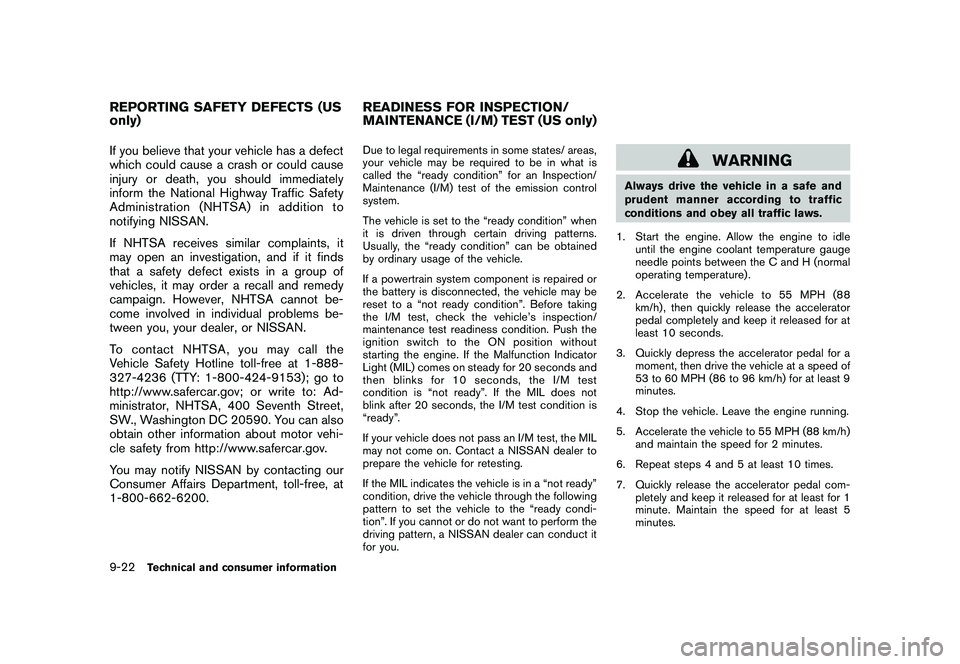
Black plate (400,1)
Model "Z34-D" EDITED: 2009/ 9/ 10
If you believe that your vehicle has a defect
which could cause a crash or could cause
injury or death, you should immediately
inform the National Highway Traffic Safety
Administration (NHTSA) in addition to
notifying NISSAN.
If NHTSA receives similar complaints, it
may open an investigation, and if it finds
that a safety defect exists in a group of
vehicles, it may order a recall and remedy
campaign. However, NHTSA cannot be-
come involved in individual problems be-
tween you, your dealer, or NISSAN.
To contact NHTSA, you may call the
Vehicle Safety Hotline toll-free at 1-888-
327-4236 (TTY: 1-800-424-9153); go to
http://www.safercar.gov; or write to: Ad-
ministrator, NHTSA, 400 Seventh Street,
SW., Washington DC 20590. You can also
obtain other information about motor vehi-
cle safety from http://www.safercar.gov.
You may notify NISSAN by contacting our
Consumer Affairs Department, toll-free, at
1-800-662-6200.
Due to legal requirements in some states/ areas,
your vehicle may be required to be in what is
called the “ready condition” for an Inspection/
Maintenance (I/M) test of the emission control
system.
The vehicle is set to the “ready condition” when
it is driven through certain driving patterns.
Usually, the “ready condition” can be obtained
by ordinary usage of the vehicle.
If a powertrain system component is repaired or
the battery is disconnected, the vehicle may be
reset to a “not ready condition”. Before taking
the I/M test, check the vehicle’s inspection/
maintenance test readiness condition. Push the
ignition switch to the ON position without
starting the engine. If the Malfunction Indicator
Light (MIL) comes on steady for 20 seconds and
then blinks for 10 seconds, the I/M test
condition is “not ready”. If the MIL does not
blink after 20 seconds, the I/M test condition is
“ready”.
If your vehicle does not pass an I/M test, the MIL
may not come on. Contact a NISSAN dealer to
prepare the vehicle for retesting.
If the MIL indicates the vehicle is in a “not ready”
condition, drive the vehicle through the following
pattern to set the vehicle to the “ready condi-
tion”. If you cannot or do not want to perform the
driving pattern, a NISSAN dealer can conduct it
for you.
WARNING
Always drive the vehicle in a safe and
prudent manner according to traffic
conditions and obey all traffic laws.
1. Start the engine. Allow the engine to idle until the engine coolant temperature gauge
needle points between the C and H (normal
operating temperature) .
2. Accelerate the vehicle to 55 MPH (88 km/h) , then quickly release the accelerator
pedal completely and keep it released for at
least 10 seconds.
3. Quickly depress the accelerator pedal for a moment, then drive the vehicle at a speed of
53 to 60 MPH (86 to 96 km/h) for at least 9
minutes.
4. Stop the vehicle. Leave the engine running.
5. Accelerate the vehicle to 55 MPH (88 km/h) and maintain the speed for 2 minutes.
6. Repeat steps 4 and 5 at least 10 times.
7. Quickly release the accelerator pedal com- pletely and keep it released for at least for 1
minute. Maintain the speed for at least 5
minutes.
REPORTING SAFETY DEFECTS (US
only) READINESS FOR INSPECTION/
MAINTENANCE (I/M) TEST (US only)9-22
Technical and consumer information
Page 401 of 409
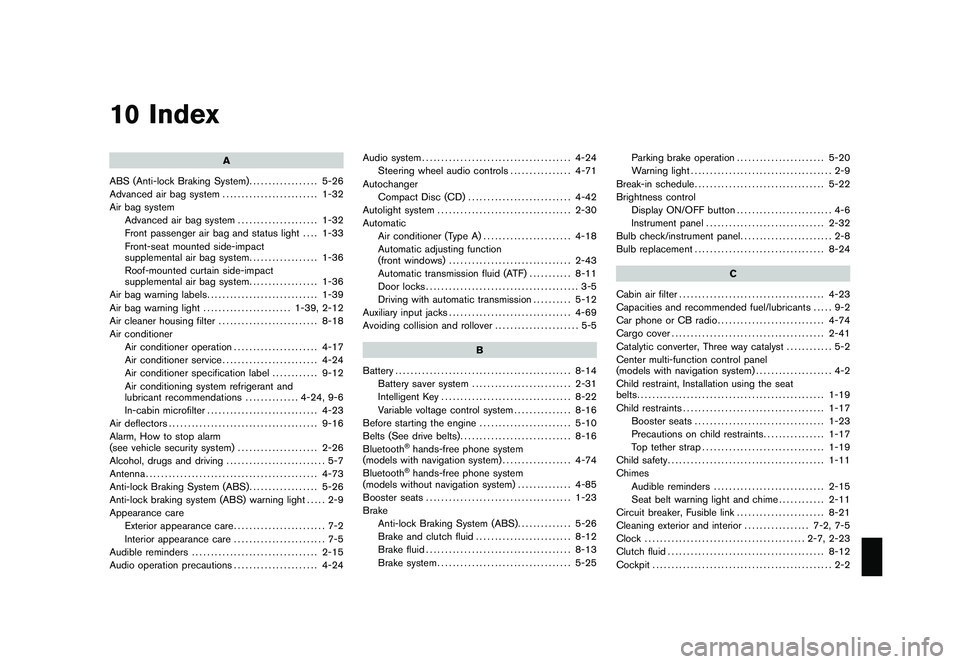
Black plate (1,1)
10 Index
A
ABS (Anti-lock Braking System) .................. 5-26
Advanced air bag system ......................... 1-32
Air bag system Advanced air bag system ..................... 1-32
Front passenger air bag and status light .... 1-33
Front-seat mounted side-impact
supplemental air bag system .................. 1-36
Roof-mounted curtain side-impact
supplemental air bag system .................. 1-36
Air bag warning labels ............................. 1-39
Air bag warning light ....................... 1-39, 2-12
Air cleaner housing filter .......................... 8-18
Air conditioner Air conditioner operation ...................... 4-17
Air conditioner service ......................... 4-24
Air conditioner specification label ............ 9-12
Air conditioning system refrigerant and
lubricant recommendations .............. 4-24, 9-6
In-cabin microfilter ............................. 4-23
Air deflectors ....................................... 9-16
Alarm, How to stop alarm
(see vehicle security system) ..................... 2-26
Alcohol, drugs and driving .......................... 5-7
Antenna ............................................. 4-73
Anti-lock Braking System (ABS) .................. 5-26
Anti-lock braking system (ABS) warning light ..... 2-9
Appearance care Exterior appearance care ........................ 7-2
Interior appearance care ........................ 7-5
Audible reminders ................................. 2-15
Audio operation precautions ...................... 4-24 Audio system
....................................... 4-24
Steering wheel audio controls ................ 4-71
Autochanger Compact Disc (CD) ........................... 4-42
Autolight system ................................... 2-30
Automatic Air conditioner (Type A) ....................... 4-18
Automatic adjusting function
(front windows) ................................ 2-43
Automatic transmission fluid (ATF) ........... 8-11
Door locks ........................................ 3-5
Driving with automatic transmission .......... 5-12
Auxiliary input jacks ................................ 4-69
Avoiding collision and rollover ...................... 5-5
B
Battery .............................................. 8-14
Battery saver system .......................... 2-31
Intelligent Key .................................. 8-22
Variable voltage control system ............... 8-16
Before starting the engine ........................ 5-10
Belts (See drive belts) ............................. 8-16
Bluetooth
®hands-free phone system
(models with navigation system) .................. 4-74
Bluetooth®hands-free phone system
(models without navigation system) .............. 4-85
Booster seats ...................................... 1-23
Brake Anti-lock Braking System (ABS) .............. 5-26
Brake and clutch fluid ......................... 8-12
Brake fluid ...................................... 8-13
Brake system ................................... 5-25 Parking brake operation
....................... 5-20
Warning light ..................................... 2-9
Break-in schedule .................................. 5-22
Brightness control Display ON/OFF button ......................... 4-6
Instrument panel ............................... 2-32
Bulb check/instrument panel ........................ 2-8
Bulb replacement .................................. 8-24
C
Cabin air filter ...................................... 4-23
Capacities and recommended fuel/lubricants ..... 9-2
Car phone or CB radio ............................ 4-74
Cargo cover ........................................ 2-41
Catalytic converter, Three way catalyst ............ 5-2
Center multi-function control panel
(models with navigation system) .................... 4-2
Child restraint, Installation using the seat
belts ................................................. 1-19
Child restraints ..................................... 1-17
Booster seats .................................. 1-23
Precautions on child restraints ................ 1-17
Top tether strap ................................ 1-19
Child safety ......................................... 1-11
Chimes Audible reminders ............................. 2-15
Seat belt warning light and chime ............ 2-11
Circuit breaker, Fusible link ....................... 8-21
Cleaning exterior and interior ................. 7-2, 7-5
Clock .......................................... 2-7, 2-23
Clutch fluid ......................................... 8-12
Cockpit ............................................... 2-2
Model "Z34-D" EDITED: 2009/ 9/ 10
Page 402 of 409
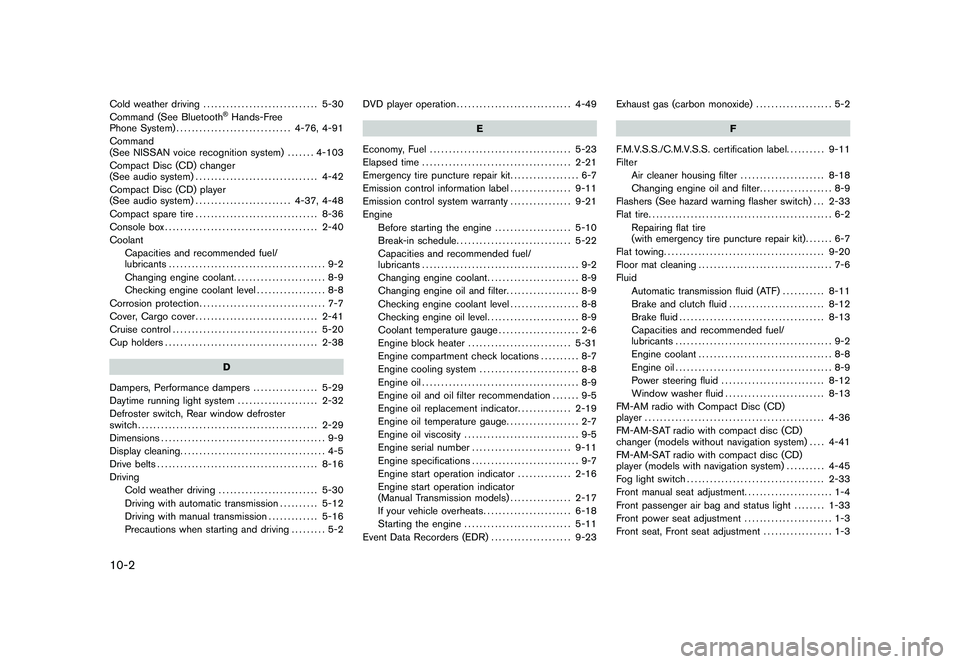
Black plate (2,1)
10-2Cold weather driving.............................. 5-30
Command (See Bluetooth
®Hands-Free
Phone System) .............................. 4-76, 4-91
Command
(See NISSAN voice recognition system) ....... 4-103
Compact Disc (CD) changer
(See audio system) ................................ 4-42
Compact Disc (CD) player
(See audio system) ......................... 4-37, 4-48
Compact spare tire ................................ 8-36
Console box ........................................ 2-40
Coolant Capacities and recommended fuel/
lubricants ......................................... 9-2
Changing engine coolant ........................ 8-9
Checking engine coolant level .................. 8-8
Corrosion protection ................................. 7-7
Cover, Cargo cover ................................ 2-41
Cruise control ...................................... 5-20
Cup holders ........................................ 2-38
D
Dampers, Performance dampers ................. 5-29
Daytime running light system ..................... 2-32
Defroster switch, Rear window defroster
switch ............................................... 2-29
Dimensions ........................................... 9-9
Display cleaning ...................................... 4-5
Drive belts .......................................... 8-16
Driving Cold weather driving .......................... 5-30
Driving with automatic transmission .......... 5-12
Driving with manual transmission ............. 5-16
Precautions when starting and driving ......... 5-2DVD player operation
.............................. 4-49
E
Economy, Fuel ..................................... 5-23
Elapsed time ....................................... 2-21
Emergency tire puncture repair kit .................. 6-7
Emission control information label ................ 9-11
Emission control system warranty ................ 9-21
Engine Before starting the engine .................... 5-10
Break-in schedule .............................. 5-22
Capacities and recommended fuel/
lubricants ......................................... 9-2
Changing engine coolant ........................ 8-9
Changing engine oil and filter ................... 8-9
Checking engine coolant level .................. 8-8
Checking engine oil level ........................ 8-9
Coolant temperature gauge ..................... 2-6
Engine block heater ........................... 5-31
Engine compartment check locations .......... 8-7
Engine cooling system .......................... 8-8
Engine oil ......................................... 8-9
Engine oil and oil filter recommendation ....... 9-5
Engine oil replacement indicator .............. 2-19
Engine oil temperature gauge ................... 2-7
Engine oil viscosity .............................. 9-5
Engine serial number .......................... 9-11
Engine specifications ............................ 9-7
Engine start operation indicator .............. 2-16
Engine start operation indicator
(Manual Transmission models) ................ 2-17
If your vehicle overheats ....................... 6-18
Starting the engine ............................ 5-11
Event Data Recorders (EDR) ..................... 9-23Exhaust gas (carbon monoxide)
.................... 5-2
F
F.M.V.S.S./C.M.V.S.S. certification label. ......... 9-11
Filter Air cleaner housing filter ...................... 8-18
Changing engine oil and filter ................... 8-9
Flashers (See hazard warning flasher switch) . . . 2-33
Flat tire ................................................ 6-2
Repairing flat tire
(with emergency tire puncture repair kit) ....... 6-7
Flat towing .......................................... 9-20
Floor mat cleaning ................................... 7-6
Fluid Automatic transmission fluid (ATF) ........... 8-11
Brake and clutch fluid ......................... 8-12
Brake fluid ...................................... 8-13
Capacities and recommended fuel/
lubricants ......................................... 9-2
Engine coolant ................................... 8-8
Engine oil ......................................... 8-9
Power steering fluid ........................... 8-12
Window washer fluid .......................... 8-13
FM-AM radio with Compact Disc (CD)
player ............................................... 4-36
FM-AM-SAT radio with compact disc (CD)
changer (models without navigation system) .... 4-41
FM-AM-SAT radio with compact disc (CD)
player (models with navigation system) .......... 4-45
Fog light switch .................................... 2-33
Front manual seat adjustment. ...................... 1-4
Front passenger air bag and status light ........ 1-33
Front power seat adjustment ....................... 1-3
Front seat, Front seat adjustment .................. 1-3
Model "Z34-D" EDITED: 2009/ 9/ 10
Page 403 of 409

Black plate (3,1)
FuelCapacities and recommended fuel/
lubricants ......................................... 9-2
Fuel economy .................................. 5-23
Fuel economy information (display) ............. 4-8
Fuel octane rating ................................ 9-3
Fuel recommendation ............................ 9-3
Fuel-filler cap ................................... 3-34
Fuel-filler door .................................. 3-34
Gauge ............................................ 2-6
Fuses ............................................... 8-20
Fusible links ........................................ 8-21
G
Garage door opener, HomeLink
®Universal
Transceiver ......................................... 2-47
Gas cap ............................................ 3-34
Gauge ................................................ 2-4
Engine coolant temperature gauge ............. 2-6
Fuel gauge ....................................... 2-6
Odometer ......................................... 2-5
Speedometer ..................................... 2-5
Tachometer ....................................... 2-5
Trip computer .................................. 2-20
General maintenance ................................ 8-2
Glove box. .......................................... 2-39
H
Hands-free phone system, Bluetooth®
(models with navigation system) .................. 4-74
Hands-free phone system, Bluetooth
®
(models without navigation system) .............. 4-85
Hatch, Rear hatch ................................. 3-17
Hazard warning flasher switch .................... 2-33Head restraints
....................................... 1-5
Headlights Bulb replacement .............................. 8-26
Headlight switch ............................... 2-30
Xenon headlights .............................. 2-29
Heated seats ....................................... 2-34
Heater Engine block heater ........................... 5-31
Heater and air conditioner operation ......... 4-17
HomeLink
®Universal Transceiver ................. 2-47
Hood release ....................................... 3-16
Horn ................................................ 2-34
I
Ignition switch (Push-button) .................................... 5-7
Automatic transmission models ............... 5-12
Manual transmission models .................. 5-16
Immobilizer system ................................. 2-26
In-cabin microfilter ................................. 4-23
Indicator lights ..................................... 2-12
INFO button .......................................... 4-6
Inside mirror ........................................ 3-36
Inspection/maintenance (I/M) test ................ 9-22
Instrument brightness control ..................... 2-32
Instrument panel ..................................... 2-3
Instrument pocket .................................. 2-38
Intelligent Key ........................................ 3-2
Intelligent Key battery discharge indicator ....... 2-17
Intelligent Key removal indicator .................. 2-17
Intelligent Key system ............................... 3-6
Battery replacement ........................... 8-22
Intelligent Key system warning light .......... 2-10
Key operating range ............................. 3-8 Key operation
.................................... 3-9
Warning signals ................................ 3-11
Interior light control switch ........................ 2-44
Interior light replacement .......................... 8-26
Interior lights ....................................... 2-44
Interior trunk lid release ........................... 3-20
iPod
®player operation ............................. 4-61
J
Jump starting ....................................... 6-15
K
Keyless entry
(See remote keyless entry system) ............... 3-13
Keys................................................... 3-2 For Intelligent Key system ....................... 3-6
L
Labels Air bag warning labels ......................... 1-39
Air conditioner specification label ............ 9-12
Emission control information label ............ 9-11
Engine serial number .......................... 9-11
F.M.V.S.S./C.M.V.S.S. certification label. ..... 9-11
Tire and Loading information label .... 8-29, 9-12
Vehicle identification number (VIN) ........... 9-10
License plate, Installing front license plate. ...... 9-13
Light Air bag warning light .......................... 1-39
Bulb replacement .............................. 8-24
Cargo area courtesy light ..................... 2-46
Cargo light ..................................... 2-46
Fog light switch ................................ 2-33
10-3
Model "Z34-D" EDITED: 2009/ 9/ 10